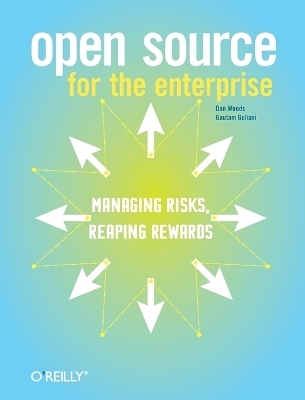
Open Source for the Enterprise
O'Reilly Media (Verlag)
978-0-596-10119-0 (ISBN)
Open source software is changing the world of Information Technology. But making it work for your company is far more complicated than simply installing a copy of Linux. If you are serious about using open source to cut costs, accelerate development, and reduce vendor lock-in, you must institutionalize skills and create new ways of working. You must understand how open source is different from commercial software and what responsibilities and risks it brings. "Open Source for the Enterprise" is a sober guide to putting open source to work in the modern IT department. Open source software is software whose code is freely available to anyone who wants to change and redistribute it. New commercial support services, smaller licensing fees, increased collaboration, and a friendlier platform to sell products and services are just a few of the reasons open source is so attractive to IT departments. Some of the open source projects that are in current, widespread use in businesses large and small include Linux, FreeBSD, Apache, MySQL, PostgreSQL, JBOSS, and Perl. These have been used to such great effect by Google, Amazon, Yahoo!, and major commercial and financial firms, that a wave of publicity has resulted in recent years, bordering on hype.
Large vendors such as IBM, Novell, and Hewlett Packard have made open source a lynchpin of their offerings. Open source has entered a new area where it is being used as a marketing device, a collaborative software development methodology, and a business model. This book provides something far more valuable than either the cheer-leading or the fear-mongering one hears about open source. The authors are Dan Woods, former CTO of TheStreet.com and a consultant and author of several books about IT, and Gautam Guliani, Director of Software Architecture at Kaplan Test Prep and Admissions. Each has used open source software for some 15 years at IT departments large and small. They have collected the wisdom of a host of experts from IT departments, open source communities, and software companies. "Open Source for the Enterprise" provides a top to bottom view not only of the technology, but of the skills required to manage it and the organizational issues that must be addressed. Here are the sorts of questions answered in the book: why is there a "productization gap" in most open source projects? How can the maturity of open source be evaluated? How can the ROI of open source be calculated?
What skills are needed to use open source? What sorts of open source projects are appropriate for IT departments at the beginner, intermediate, advanced, and expert levels? What questions need to be answered by an open source strategy? What policies for governance can be instituted to control the adoption of open source? What new commercial services can help manage the risks of open source? Do differences in open source licenses matter? And how will using open source transform an IT department?
Dan Woods, a seasoned CTO, has built technology for companies ranging from Time Inc. New Media to TheStreet.com. He has managed the product development cycle from initial requirements through sales for web sites and software products designed for the publishing and financial services industries. Dan has also navigated all phases of the business cycle: crafting strategy and budgets, building and managing large development teams, writing patent applications, negotiating large vendor agreements, operating data centers, communicating with board members, raising money, and selling and marketing a product. Dan is the author of two books and a frequent contributor to InfoWorld and other publications.
Preface 1. The Nature of Open Source The Open Source Debate Understanding Your Open Source Readiness The Nature of Open Source What Is Open Source? Where Does Open Source Come From? How Does Open Source Grow? How Does Open Source Die? Leadership in the Open Source Life Cycle Second-Generation Trends in Open Source The Different Roots of Commercial Software Productization: The Key to Understanding the Challenge of Using Open Source Comparing the Risks of Commercial and Open Source Software 2. Measuring the Maturity of Open Source Open Source Traps The Elements of Open Source Maturity The Open Source Maturity Model 3. The Open Source Skill Set Preventing an Open Source Nightmare Open Source Skill Levels Open Source Skills Inventory How Maturity Affects Required Skills and Resources Skills and Risks Open Source Skill Building 4. Making the ROI Case ROI Fashions How Open Source Costs Differ from Commercial Software Costs Making Your Own ROI Model Skills Versus Money 5. Designing an Open Source Strategy Crafting a Strategy for Open Source Adoption Crafting a Strategy for Applying Open Source Crafting a Strategy for Managing Open Source 6. Support Models for Open Source Open Source Support Offers When Is Commercial Open Source Support the Right Choice? Buy Carefully 7. Making Open Source Projects Easy to Adopt One Program for Productization Basic Information and Community Support Reducing the Skills Gap for Getting Started Accelerating Learning Integration Benefits of Increased Adoption Opportunities for Skill Building 8. A Comparison of Open Source Licenses Many Flavors of Licenses The Classic Licenses The BSD Licenses: FreeBSD, OpenBSD, and NetBSD The MIT License Second-Generation/Single-Project Licenses Corporate Licenses Why Pick Just One? The Dual Licensing Option 9. Open Source Under Attack SCO Versus IBM and the Legal Quandary of Open Source What You Need to Know About SCO What It All Means: The Implications of the SCO Crisis 10. Open Source Empowerment Two Poles of IT: Buy Versus Build Where to Buy, Where to Build Closing the Requirements Gap Open Source Empowerment The Vision and Challenge of IT A. The Open Source Platform B. End-User Computing on the Desktop C. Open Source and Email D. Groupware, Portals, and Collaboration E. Web Publishing and Content Management F. Application Development Index
| Erscheint lt. Verlag | 30.8.2005 |
|---|---|
| Reihe/Serie | O'Reilly Ser. |
| Verlagsort | Sebastopol |
| Sprache | englisch |
| Einbandart | kartoniert |
| Themenwelt | Mathematik / Informatik ► Informatik ► Web / Internet |
| ISBN-10 | 0-596-10119-8 / 0596101198 |
| ISBN-13 | 978-0-596-10119-0 / 9780596101190 |
| Zustand | Neuware |
| Haben Sie eine Frage zum Produkt? |
aus dem Bereich


